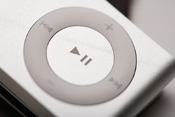
|
|
MP3 devices that are affordable for your business

In the olden days (which is about 15 or more years ago), computer files were smaller and files were commonly moved from one computer to another using diskettes. Digital audio and video existed, but they were not widely used on computers because computer hard drives were not big enough to hold them.
As computer hard drives were able to store more and more data, the software developers were happy to use up the space on the hard drives with bigger and bigger files. Multimedia files with digital sounds, pictures, and video began to come of age in the late nineties. This began to pose a problem for computer users in the business world as well as at home. Diskettes began to be inadequate as a means of moving files around.
A means needed to be invented to hold more data, so devices in the business world began to be used called jump drives and zip drives. But as networks became faster, and with the internet becoming universal, transferring files through the network became the preferred way to transfer files from one computer to another.
|
|
Also, around the late nineties, a new phenomenon began to take place. WAV files were the most commonly used audio file before the MP3 file. MP3 is short for MPEG-1 Layer 3. MP3 files are much smaller than the equivalent WAV file, but to the human ear they don't sound any different. These MP3 audio files began to widely be proliferated on the internet, but you needed a computer to enjoy them. The need to be able to store large amounts of data on a small device that could play these files was needed. A smaller means of storing large amounts of data for other reasons was also desperately desired by computer users.
The USB flash drive entered the scene and began to be widely used. The first flash drives that were affordable could only hold about 128 kilobytes to 256 kilobytes. Nevertheless, because of the ease of use, and the ability to attach the device directly to a USB port (which also began to be widely used with computers around the same time), flash drives were the next best thing.
In the digital audio world, there was a problem with the proliferation of illegal music. The music industry didn't like the fact that their music could be sent out to millions of listeners for free. Apple computers saw an opportunity to not only take advantage of the latest technologies for digital audio, but also saw a way to make digital audio a more legitimate enterprise. They invented the iPod and iTunes to solve this problem. Of course, many of the other manufacturers followed their lead. Today, MP3 players not only serve as music devices, but many of them can play video, can record audio, and can also serve as a flash drive to store any computer file where you need portability.
Apple computers recently released the iPhone. It combines palm top computing, cellular phone technology and iPod audio and video technology all on a single device. This device is currently not very affordable, but other manufacturers are sure to copy it, just as they have done with the iPod. Before long, devices such as this will be widely used in business.
Today, MP3 music players which double as flash drives are very inexpensive. Some of them are as low as twenty dollars. For about a 1 gigabyte capacity, you could plan on paying around forty dollars. But these units don't have a lot of business applications yet, but when the iPhone technology becomes cheaper, this is sure to have an impact on the business world.
Privacy Policy, Terms of Use